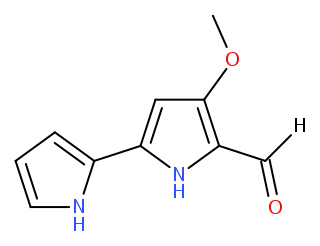
Kelps are large brown algae or seaweeds that make up the order Laminariales. There are about 30 different genera. Despite its appearance, kelp is not a plant but a stramenopile.
Pseudoalteromonas is a genus of marine bacteria. In 1995, Gauthier et al proposed Pseudoalteromonas as a new genus to be split from Alteromonas. The Pseudoalteromonas species that were described before 1995 were originally part of the genus Alteromonas, and were reassigned to Pseudoalteromonas based on their rRNA-DNA analysis.

Konbu is edible kelp mostly from the family Laminariaceae and is widely eaten in East Asia. It may also be referred to as dasima or haidai.

Laminaria is a genus of brown seaweed in the order Laminariales (kelp), comprising 31 species native to the north Atlantic and northern Pacific Oceans. This economically important genus is characterized by long, leathery laminae and relatively large size. Some species are called Devil's apron, due to their shape, or sea colander, due to the perforations present on the lamina. Others are referred to as tangle. Laminaria form a habitat for many fish and invertebrates.
Pseudoalteromonas atlantica is a marine bacterium, which has been shown to act as a primary producer of biofilms and exhibit virulence against Cancer pagurus, a species of crab, through secretion of extracellular products.
Lambda-carrageenase is an enzyme which breaks down a polysaccharide found in red seaweeds, lambda-carrageenan. This enzyme has only been found in marine bacteria.
Algicola is a genus in the phylum Pseudomonadota (Bacteria).
Pseudoalteromonas phenolica is a marine bacterium species in the genus Pseudoalteromonas.
Pseudoalteromonas agarivorans is a marine bacterium.
Pseudoalteromonas aurantia is an antibacterial-producing marine bacterium commonly found in Mediterranean waters. In 1979, Gauthier and Breittmayer first named it Alteromonas aurantia to include it in the genus Alteromonas that was described seven years earlier, in 1972 by Baumann et al. In 1995, Gauthier et al renamed Alteromonas aurantia to Pseudoalteromonas aurantia to include it in their proposed new genus, Pseudoalteromonas, which they recommended splitting from Alteromonas.
Pseudoalteromonas distincta is a marine bacterium.
Pseudoalteromonas elyakovii is a marine bacterium.
Pseudoalteromonas issachenkonii is a marine bacterium which was isolated from the brown alga Fucus evanescens near the Kurile Islands.
Pseudoalteromonas peptidolytica is a marine bacterium isolated from the sea surrounding Yamato Island in the Sea of Japan.
Pseudoalteromonas prydzensis is a marine bacterium isolated from Antarctic sea ice.
Pseudoalteromonas rubra is a marine bacterium that belongs to the domain Bacteria, phylum Pseudomonadota, class Gammaproteobacteria, order Alteromonadales, family Pseudoalteromonadaceae, and genus Pseudoalteromonas. This bacterium is Gram-negative and rod-shaped, which is typical for many marine bacteria. It is also motile, meaning it has the ability to move independently, which can be advantageous in its natural habitat.
Pseudoalteromonas tetraodonis is a marine bacterium isolated from the surface slime of the puffer fish. It secretes the neurotoxin, tetrodotoxin. It was originally described in 1990 as Alteromonas tetraodonis but was reclassified in 2001 to the genus Pseudoalteromonas.
Pseudoalteromonas tunicata is a marine bacterium isolated from the tunicate Ciona intestinalis.
Pseudoalteromonas marina is a marine bacterium isolated from tidal sediment near Chungnam.

Tambjamines are a group of natural products that are structurally related to the prodiginines. They are enamine derivatives of 4-methoxy-2,2'-bipyrrole-5-carboxaldehyde (MBC).



